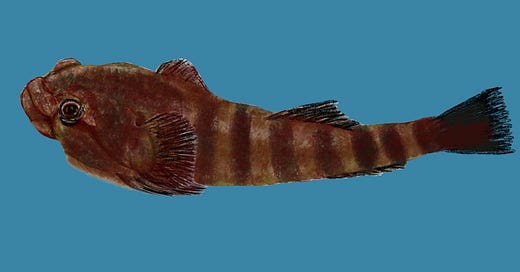When I used to live in Chorrillos, a fishing village on the southern end of Lima, Peru that was swallowed up by the city’s urban sprawl, I occasionally would see men with long poles climbing down the coastal cliffs, where waves crashed were crashing into the rocky shore. Later I learned that they were catching pejesapo (Sicyases sanguineus), a fish I have grown fond of in recent years.
Often called the Chilean clingfish or frogfish in English (though not to be confused with anglerfish and others with the same moniker), pejesapo is not a pretty fish. It has an oversized head with protruding front teeth and a large sucker mouth that allows it to hold on to rocks and along the ocean floor. A member of the Gobiesocidae family, quite similar to monkfish (which can also be used in the recipe below), its range extends from Valdivia in southern Chile to central Peru.
In coastal villages within this range, such as Chorrillos, men called pejesaperos catch them with these long poles that have nets or hooks attached to them so they can pick the fish if spotted. Pejesapo can live for more than a day out of water and are often seen on rock walls and tidal pools exposed to the open air. Maybe it’s because I’m never there in the early mornings jogging along the coast anymore, but I haven’t seen a pejesapero in Chorrillos in years. Perhaps they are all gone, that the older generations that ate the fish are no longer around so the market has gradually faded. In a world where everyone prefers fillets of lenguado (sole) and corvina (seabass), they aren’t quite sure what to do with a fatty, unattractive fish that is difficult to break down and often needs to be cooked whole.
Yet, it should be consumed. Pejesapo is a non-threatened species and it’s quite delicious. It has been consumed since Pre-Colombian times and historically, it was used in various soups, like caldillo de pejesapo, chupín de pejesapo or sudado de pejesapo, which all cook it in some combination of fish stock, tomatoes, chiles and various aromatics. Like monkfish, it has a beautiful gelatinous texture. It’s a very delicate fish and if overcooked, which doesn’t take a lot, it falls apart.
In Lima, pejesapo has had a limited resurgence in restaurants in recent years. At La Mar in Miraflores, they have cooked it whole on a wood fired grill. At Maido, also in Miraflores. Mitsuharu Tsumura has battered and fried a pejesapo filet tempura-style and set it on a bao, topping it with salsa criolla and lettuce. The most consistent preparation of pejesapo that you will see in Lima, however, is at Nikkei and Chinese restaurants, who steam it, called pejesapo al sillao or pejesapo al vapor. Here is the recipe:
Keep reading with a 7-day free trial
Subscribe to New Worlder to keep reading this post and get 7 days of free access to the full post archives.




